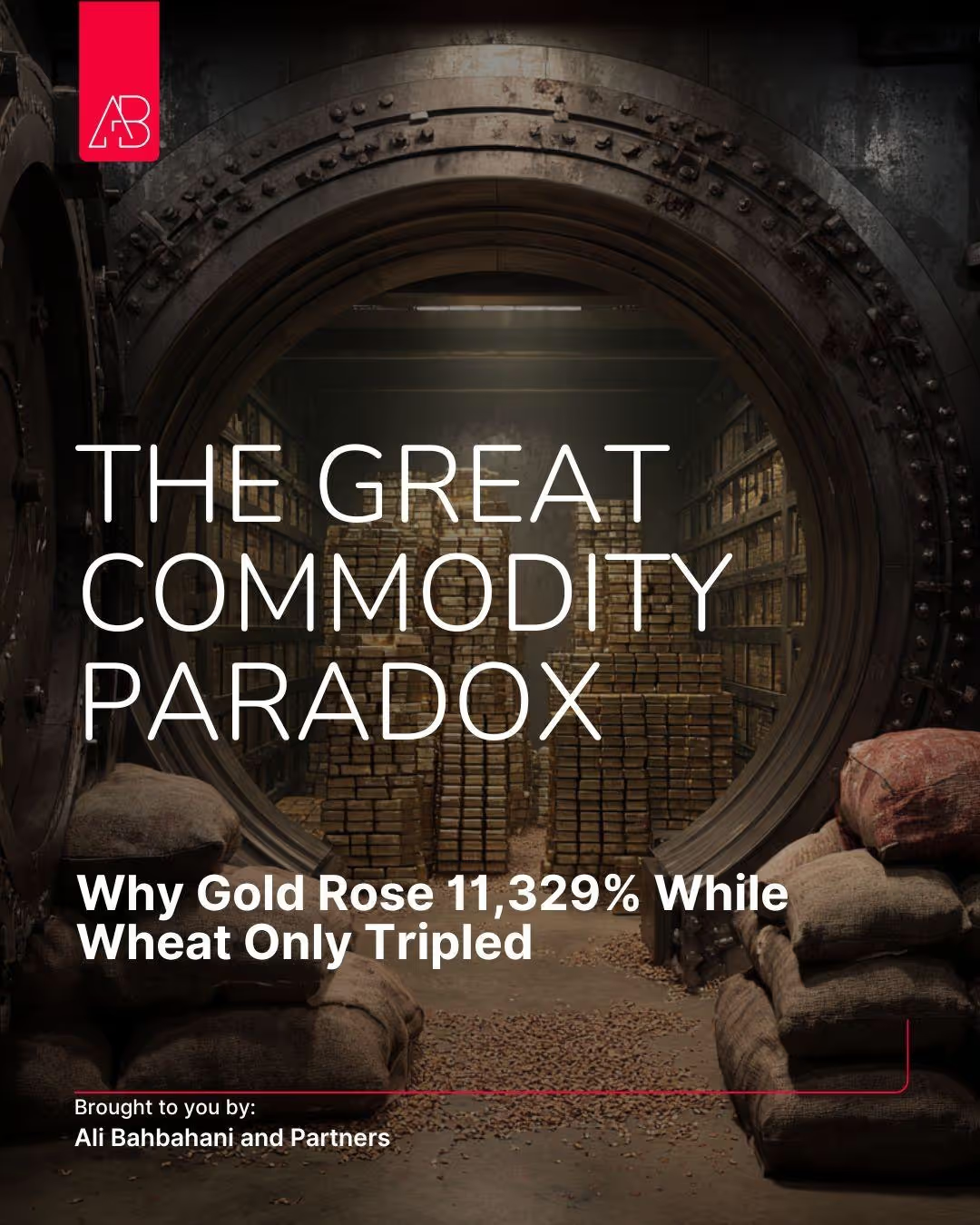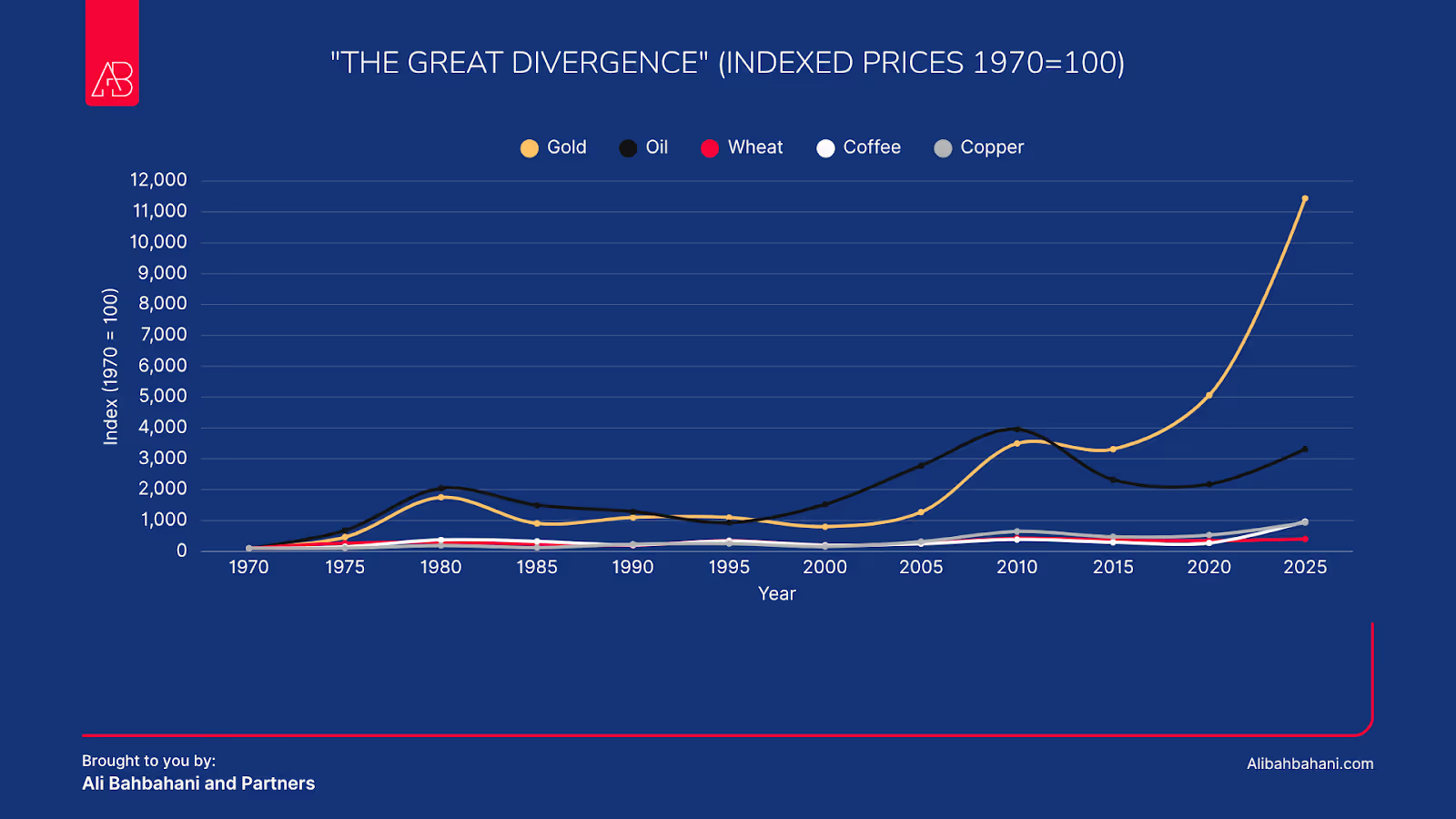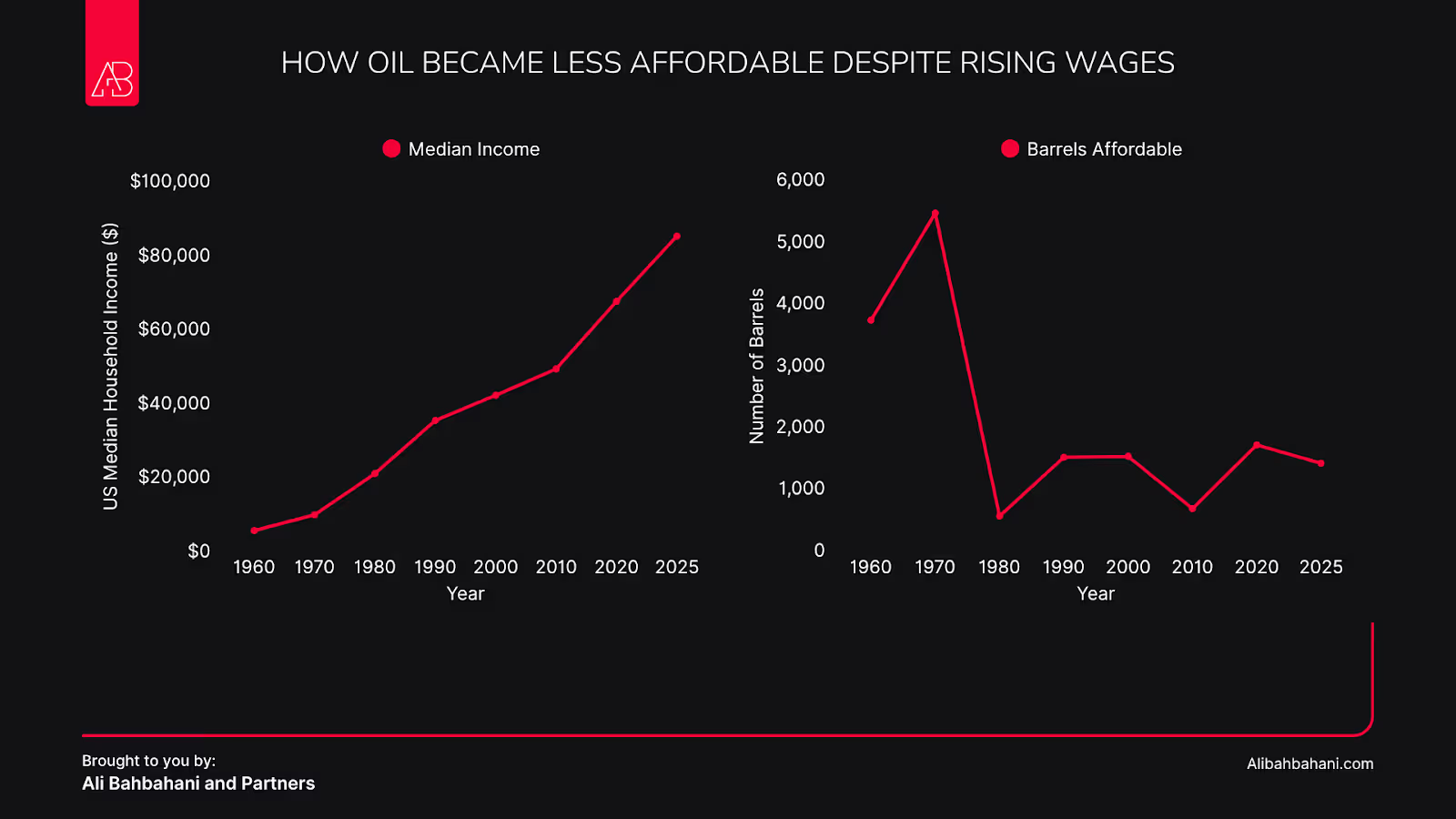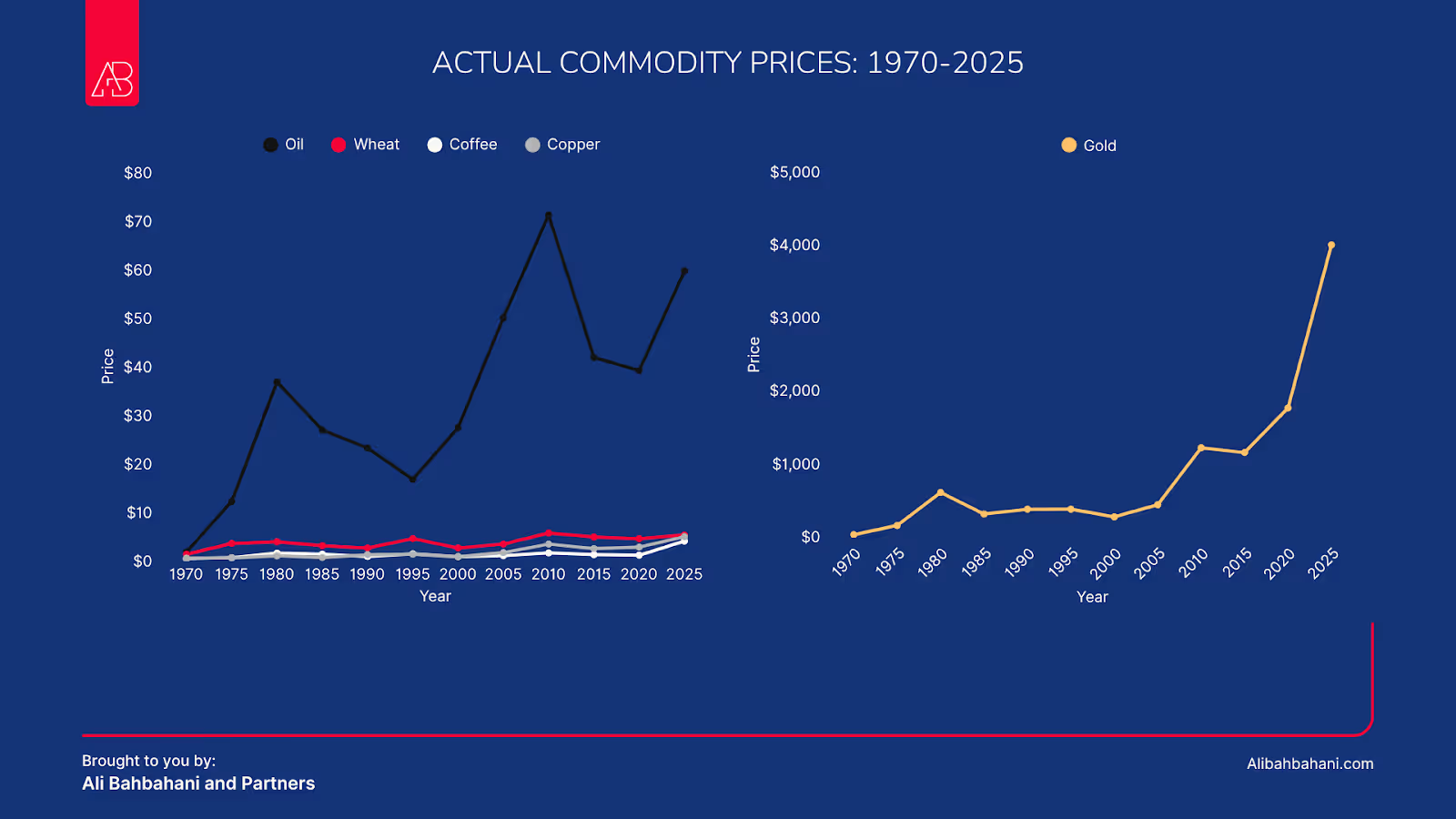The Great Commodity Paradox: Why Gold Rose 11,329% While Wheat Only Tripled


What 55 Years of Price Data Reveals About Markets, Manipulation, and What We Actually Need
Gold just hit $4,000 per ounce, and I couldn't stop thinking about one question: Why gold?
Not "why are gold prices rising?" That's obvious enough with inflation fears and geopolitical uncertainty. My question was more fundamental: Why has gold become the reserve asset for nations? Why do central banks hoard gold and not, say, oil? Oil is more liquid, produced at higher volumes, has actual daily demand, and you can use it. Why not store oil as a reserve? Or wheat, which you can eat? Or coffee, which the world consumes 2 billion cups of daily?
What makes a shiny metal that sits in vaults doing nothing the ultimate store of value?
I started digging, and what I found was far more interesting than I expected. This isn't just a story about gold. It's a story about what happened when we broke the link between money and tangible value, and why the commodities that keep us alive have remained remarkably affordable. In contrast, the ones we want to own have exploded in price.
The Journey Starts With A Simple Question
Gold is currently trading around $4,000- $ 4,010 per ounce (as of November 7, 2025). In 1970, before President Nixon severed the dollar's tie to gold, it was fixed at $35 per ounce. That's an 11,329% increase—a 114-fold multiplication.
During the same period:
- Wheat went from $1.33 to $5.30 per bushel (298% increase, 4x multiple)
- Oil went from $1.80 to $59.67 per barrel (3,215% increase, 33x multiple)
- Coffee increased 864% (9.6x multiple)
- Copper rose 834% (9.3x multiple)
The commodity with the least utility for human survival became the most valuable.
This didn't make sense to me. So I did what any curious person would do: I pulled 55 years of commodity price data and started comparing. But as I dug deeper, I realized the story goes back much further, to the 1860s, when these commodities first began trading in organized markets.
The Price Divergence: What Happened Since 1970
Here's how dramatically these five commodities diverged over 55 years:
- Gold rose from $35.00 per ounce in 1970 to $4,005 per ounce in November 2025—an increase of 11,329%, multiplying 114 times its original value.
- Coffee increased from $0.42 per pound to $4.05 per pound—up 864%, a 9.6x multiple.
- Copper climbed from $0.53 per pound to $4.95 per pound—up 834%, a 9.3x multiple.
- Oil (WTI) rose from $1.80 per barrel to $59.67 per barrel—up 3,215%, a 33x multiple.
- Wheat grew from $1.33 per bushel to $5.30 per bushel—up just 298%, only 4 times its 1970 price.
The metal you can't eat, use, or burn became 114 times more expensive. The grain that feeds billions became only 4 times more expensive.

Why Gold? The Question Nobody Asks
Let me walk you through my thinking process, because it reveals something profound about how our economic system actually works.
Why not oil as a reserve asset?
Think about it logically:
- Global oil supplies reach 102.9 million barrels per day, it's the most traded commodity in the world by volume and value
- Every country needs it constantly
- It powers transportation, industry, heating, and electricity
- It's highly liquid, you can sell oil anywhere, anytime
- Storage technology exists (strategic petroleum reserves prove this)
- Unlike gold, it has genuine daily utility
If you're a nation trying to store value, why wouldn't you store the one commodity that literally powers the modern world?
Why not wheat as a reserve asset?
Or take wheat:
- Essential for bread, pasta, and animal feed production, making it crucial to food security
- Major producers include Russia, the US, Canada, and Australia
- Everyone needs to eat, demand is guaranteed
- Can be stored (grain silos have existed for millennia)
- In a real crisis, you can eat wheat. You can't eat gold.
Why not coffee?
Coffee seemed absurd at first, but:
- Around 2 billion cups are consumed daily across the globe
- It's one of the most traded commodities globally
- Stable demand, limited growing regions
- High value per unit weight
Obviously, coffee isn't practical as a reserve (spoilage, etc.). Still, it made me realize: we've collectively decided that gold is valuable not because of what it does, but because we all agree it is.
The Answer: Gold's Unique Properties
After researching, I found that gold became the reserve asset for specific, almost mundane reasons:
Physical Properties:
- Doesn't corrode or decay (wheat rots, oil degrades)
- Divisible into any size without losing value
- Uniform quality (an ounce is an ounce, anywhere)
- Dense (high value per volume for storage)
- It can't be manufactured or synthesized easily
Economic Properties:
- Limited industrial use means demand doesn't fluctuate wildly
- No expiration date (unlike food commodities)
- Cross-cultural acceptance spanning millennia
- Scarce enough to be valuable, abundant enough to circulate
But here's what really clicked for me: Gold works as a reserve precisely because it's useless for daily life.
Oil's utility is its weakness as a store of value. Prices fluctuate based on seasonal demand, geopolitical supply, technological shifts, and constant consumption. Wheat gets consumed and spoils. The very qualities that make these essential for survival make them terrible as monetary reserves.
Gold's uselessness is its strength. Because nobody needs gold for anything critical, its value isn't tied to harvest cycles, consumption patterns, or technological substitution.
The Longer View: 165 Years of Price History
When I expanded my research back to the 1860s, the paradox became even more striking:
Wheat (1860-2025): Starting at around $1.00 per bushel in 1860, wheat hovered between $0.70-$1.50 through the early 20th century. By 1950: ~$1.50, 1980: ~$3.50, 2000: ~$2.50, and 2025: ~$5.30. That's only a 5.3x increase over 165 years.
Corn (1860-2025): From ~$0.50 in 1860 to ~$4.29 in 2025. An 8.6x increase over 165 years.
Oil (1861-2025): Crude oil started at $0.49 per barrel in 1861, fluctuating around $1-3 through the 1960s. Today at ~$60, that's a 122x increase from 1861.
Gold (1860-2025): Fixed at $18.93-$20.65 per ounce under the gold standard from 1860 to 1930, jumping to $34.72 after the 1930s devaluation. After 1971, it exploded to today's $4,000. That's a staggering 194x increase from its 1860 baseline.
The pattern is clear: Over the most extended timeframe, essentials that sustain life showed minimal price growth, while speculative assets exploded.
A Century of Stability: Commodity Prices Before 1971
For decades under the gold standard and Bretton Woods system, commodity prices remained remarkably stable:
- In 1900, gold was fixed at $20.67 per ounce, oil cost $1.19 per barrel, and wheat sold for $0.62 per bushel. This was the Gold Standard era.
- By 1920, after World War I, wheat spiked to $2.14 per bushel and oil briefly jumped to $3.07 per barrel, but gold remained locked at $20.67.
- Through the Great Depression (1930), oil returned to $1.19, wheat to $1.00, and gold stayed at $20.67.
- In 1940, following the 1934 gold revaluation, gold was reset to $35.00 per ounce. Oil cost $1.02 and wheat had fallen to $0.53 per bushel.
- Post-World War II (1950), oil climbed to $2.51 and wheat to $2.00, while gold remained fixed at $35.00.
- During the Bretton Woods era (1960), oil was $1.50, wheat $1.78, and gold still $35.00—demonstrating remarkable price stability.
- In 1970, the last year of the gold standard, oil sat at $1.80, wheat at $1.33, and gold at $35.00. This was the calm before the storm.
Notice the pattern: for 70 years, from 1900 to 1970, gold's price barely moved. Oil and wheat fluctuated with wars and harvests but remained within predictable ranges. Everything was anchored.

Why Did Food Stay So Cheap? The Green Revolution Story
Wheat and corn stayed cheap because of one of humanity's most outstanding achievements, the Green Revolution.
Starting in the 1960s, agricultural scientists like Norman Borlaug developed high-yield wheat varieties with short, sturdy stems, drought resistance, and responsiveness to fertilizers. Combined with mechanized farming, pesticides, and irrigation, this transformed global food production.
The results were extraordinary:
- Wheat yields per acre more than doubled
- Corn production exploded from 300 million tons to 1.2 billion tons
- Food crises that would have killed millions were averted
- Prices stayed accessible even as the population grew from 3 billion to 8 billion
This is why wheat increased only 5x over 165 years, while gold increased 194x. Technology and policy conspired to keep "hunger fighters" affordable.
But there's a dark side: cheap food squeezes farmers. Many agricultural producers barely break even, subsidized by governments or forced into debt. The affordability that feeds billions comes at a cost to the people who grow our food.
The Nixon Shock: When Everything Changed
This is where 1971 becomes the inflection point for everything.
On August 15, 1971, President Richard Nixon canceled the convertibility of the US dollar into gold, allowing the price of gold to float freely on the market. This ended the Bretton Woods Agreement, established in 1944, and ushered in the era of floating exchange rates.
Nixon figured out something remarkable: The US didn't need gold backing to make people believe in the dollar. After 1971, the US could print as many dollars as it wanted, unconstrained by gold reserves. The dollar remained the global reserve currency not because of gold backing, but because of US economic power, military strength, and the fact that oil trades in dollars.
But here's what happened to commodity prices after that decision:
The Bretton Woods system had created fixed exchange rates pegged to gold at $35 per ounce. From 1861 through the 1960s, commodity prices remained remarkably stable. Oil hovered between $1.30 and $1.50 per barrel throughout the 1960s. When this system collapsed in the early 1970s, commodities became volatile for the first time in over a century. The 1970s commodities boom was unprecedented. From 1972 to 1973, commodity prices rose 63%, and from 1971 to 1974, they increased 159%.
Suddenly, freed from their moorings, commodities split into two categories:
Essential Commodities:
- Wheat: $1.33 → $5.30/bushel (298% increase)
- Oil: $1.80 → $59.67/barrel (3,215% increase)*
Speculation & Store-of-Value Commodities:
- Gold: $35 → $4,005/oz (11,329% increase)
- Coffee: $0.42 → $4.05/lb (864% increase)
- Copper: $0.53 → $4.95/lb (834% increase)
*That asterisk on oil is crucial—we'll get to it.
We broke the link between currency and tangible assets, and immediately, the market began rewarding speculation over sustenance.
The Years That Changed Everything: Major Economic Shocks
- 1971 - The Nixon Shock: President Nixon decoupled gold from the dollar. Gold immediately jumped to $40.80 per ounce, oil rose to $2.24 per barrel, and wheat climbed to $1.34 per bushel. The anchor was cut loose.
- 1973 - OPEC Oil Embargo Begins: In response to the Yom Kippur War, OPEC launched its oil embargo. Gold soared to $97.32, oil spiked to $3.29, and wheat jumped to $3.95 as commodity markets entered crisis mode.
- 1974 - Oil Crisis Peak: The embargo's full impact hit. Gold reached $159.26, oil peaked at $11.58 (up 500% from 1970), and wheat hit $4.09. The world learned that essential commodities could be weaponized.
- 1980 - Gold & Oil Historic Highs: Gold peaked at $612.56 amid inflation fears and the Iranian Revolution. Oil hit $36.83 as the second oil shock gripped global markets. Wheat was $3.91, still relatively modest.
- 2008 - Global Financial Crisis: Gold reached $871.96 as investors sought safe havens. Oil spiked to $91.48 before crashing. Wheat jumped to $6.78 during the food crisis but quickly stabilized.
- 2020 - COVID-19 Pandemic: Gold climbed to $1,770.75 as uncertainty peaked. Oil briefly crashed to $39.16 as demand evaporated. Wheat remained steady at $4.53, proving food markets stayed rational even in crisis.
- November 2025 - Gold All-Time High: Gold hit $4,005.00, continuing its relentless climb. Oil settled at $59.67, below its 2008 peak. Wheat remained affordable at $5.30, barely changed from five years earlier.
These milestones tell the story: geopolitical shocks drove oil volatility, gold became a fear gauge, and wheat stayed remarkably stable through it all.

The Oil Story: What Happens When Organizations Seize Markets
Oil fascinates me because it sits between these two worlds. It's essential, but its price history looks more like speculation than necessity.
Between 1861 and 1970, oil prices remained below $5 per barrel. The market price hovered between $1.30 and $1.50 per barrel throughout the 1960s.
For over a hundred years, oil was stable. Then came 1973.
The 1973 OPEC oil embargo, followed by the 1979 Iranian Revolution, created price spikes without precedent. These weren't market corrections; they were deliberate political acts.
The 1973 OPEC embargo by GCC states quadrupled prices to ~$12 by 1974. The 1979 Iranian Revolution pushed them to $36.83 in 1980. By 2008, they peaked at $91.48. Today they're at ~$60.
Here's what struck me: Oil's dramatic price increase didn't happen because oil became scarce. It happened because an organization was formed, and nations weaponized the supply.
When I compared oil prices to median US wages, the effect became clear
How Oil Became Less Affordable While Wheat Stayed Accessible
Let's look at what a median-income American family could actually buy with one year's earnings:
- In 1960, a family earning the median income of $5,620 could afford to buy 3,747 barrels of oil at $1.50 per barrel, or 3,157 bushels of wheat at $1.78 per bushel.
- By 1970, median income rose to $9,867. Oil was $1.80, meaning a family could now buy 5,482 barrels—even more affordable than before. Wheat at $1.33 meant they could afford 7,418 bushels.
- Then came 1980 and the oil shocks. Despite median income jumping to $21,023, oil at $36.83 meant a family could only afford 571 barrels—a 90% collapse in affordability from 1970. Wheat at $3.91 allowed 5,377 bushels, down but still substantial.
- In 2000, with median income at $42,148, oil had moderated to $27.39, allowing 1,539 barrels. Wheat at $2.62 meant they could buy 16,088 bushels—wheat had become even more affordable than in 1960.
- By 2020, median income reached $67,521. Oil at $39.16 meant 1,724 barrels. Wheat at $4.53 allowed 14,907 bushels—still far more affordable than oil.
- Today (November 2025), median income is $85,157. Oil at $59.67 means a family can afford 1,428 barrels—2.6 times less affordable than in 1960, despite incomes rising 15-fold. Wheat at $5.30 means they can buy 16,067 bushels—essentially the same affordability as 1960.
- The key finding: Despite massive income growth, oil became 2.6x less affordable due to OPEC manipulation. Wheat, governed by genuine market forces, maintained its affordability across 65 years.

In 1960, a median-income family could buy 3,747 barrels of oil with one year's income. Today, despite income rising to $85,157, that same family can only buy 1,428 barrels, a 2.6x decrease in affordability.
This is why oil could never be a reserve asset like gold. Oil's price is too easily manipulated by the handful of nations that control supply through OPEC. Gold has no equivalent organization; it's distributed globally, and no single group can control its price through supply manipulation alone.
Without those Gulf-led shocks starting in 1973, oil might have mirrored the flat trajectory of agricultural staples. Its volatility stems from interference, not inherent scarcity.
Gold: The Ultimate Psychological Asset
Why did gold specifically explode in value after 1971?
The answer is beautifully circular: Gold became more valuable precisely because we stopped using it as money.
When gold-backed currencies were in use, their prices were fixed. But the moment Nixon cut that link, gold became a hedge against the very fiat currencies it once backed.
Gold prices soared from around $35 per ounce when it began free-floating in 1971 to over $4,000 by 2025. The metal increasingly serves as a safe-haven asset amid economic uncertainty, as central banks accumulate massive reserves.
Think about the psychology:
- Before 1971: Gold backs money → Gold's value is fixed
- After 1971: Nothing backs money → Gold's value floats → Money seems less reliable → People buy gold → Gold's price soars
We created a self-reinforcing loop. The less our money is tied to anything tangible, the more we value the tangible thing we used to tie it to.
And here's the kicker: Among professional traders today, gold accounts for 99.55% of commodity CFD trades, dwarfing oil at just 0.27%.
The market has spoken, speculation on the inessential dominates over trading in the essential.
The Coffee Phenomenon: When Desire Meets Supply
According to the U.S. Bureau of Labor Statistics, coffee prices are 873% higher in 2025 than in 1967, with an average inflation rate of 4% per year, higher than the overall inflation rate of 3.98% during the same period.
Coffee wholesale prices ranged from ~$0.15 to $0.20 per pound in the late 1800s, rising to ~$0.42 in 1970 and ~$4.05 today. That's a 9.6x increase.
Recent coffee prices reached an all-time nominal high of $4.34 per pound, over 250% higher than mid-2023, driven by extreme weather, supply chain disruptions, and growing demand for specialty coffee, particularly in Asia.
What's instructive about coffee: When a commodity transitions from utility to lifestyle, pricing dynamics change, but not as dramatically as you'd expect.
Despite café culture and the "$7 latte" economy, coffee prices have been tempered by oversupply from Brazil and Vietnam. Global trade reaches ~170 million bags annually, and expanding plantations keep wholesale prices relatively grounded.
Coffee behaves more like an agricultural staple than like gold, proving that even "luxuries" can stay affordable if production keeps pace with demand.
Three Forces That Explain The Paradox
After analyzing 165 years of data, I can distill this paradox down to three fundamental forces:
1. Supply Innovation Agricultural commodities, wheat, corn, and coffee benefit from technology-driven abundance. The Green Revolution created explosive supply growth that outpaced population growth.
Oil and gold face inherent limits. You can't engineer new gold deposits. Oil reserves are finite, and while fracking has extended supply, it can't match the productivity gains of agriculture.
2. Geopolitics and Monopoly Oil's price surges stem from interference by Gulf powers and the OPEC organization, which is impossible in decentralized farming. When Saudi Arabia or Russia turns the supply tap, prices spike.
Wheat and corn production is scattered across thousands of producers in dozens of countries. No farmer can manipulate global prices.
Gold sits in between, no single nation controls supply, but speculative trading creates its own manipulation through herd behavior and central bank policies.
3. Demand Nature Essentials like grains have steady, predictable demand, people buy what they need to survive.
Gold's speculative demand is entirely driven by psychology. When fear rises, demand surges. When markets calm, it falls.
Oil combines the worst of both: industrial demand creates a baseline, but geopolitical speculation adds wild swings on top.
The Divergence Visualized: Setting 1970 as the Baseline (Index = 100)
If we set all commodities at 100 in 1970 and track how they've grown, the divergence becomes stark:
- By 1980, just a decade later: Gold exploded to 1,750 (17.5x). Oil shot to 2,046 (20x) during the crisis years. Wheat climbed to 294 (3x). Coffee reached 371 (3.7x). Copper stood at 191 (1.9x).
- By 1990, after the oil crisis subsided: Gold settled at 1,096 (11x). Oil normalized to 1,288 (13x). Wheat fell to 196 (2x). Coffee dropped to 205 (2x). Copper recovered to 232 (2.3x).
- By 2000, as the dot-com era peaked: Gold actually declined to 797 (8x), below its 1980 level. Oil was 1,522 (15x). Wheat remained flat at 197 (2x). Coffee at 195 (2x). Copper at 155 (1.5x).
- By 2010, following the 2008 financial crisis: Gold surged to 3,499 (35x). Oil peaked at 3,956 (40x). Wheat climbed to 429 (4.3x). Coffee reached 383 (3.8x). Copper jumped to 645 (6.5x).
- By 2020, through the pandemic: Gold reached 5,059 (50x). Oil fell to 2,176 (22x) as demand crashed. Wheat was 341 (3.4x). Coffee at 269 (2.7x). Copper at 528 (5.3x).
- Today (November 2025): Gold dominates at 11,443 (114x). Oil at 3,315 (33x). Wheat at just 398 (4x). Coffee at 964 (9.6x). Copper at 934 (9.3x).
- The pattern is unmistakable: Gold, the useless metal, grew 28 times more than wheat, the essential grain. Markets rewarded speculation over sustenance.

What Markets Look Like When They Actually Work
A median-income American household in 2025 (earning $85,157) can buy roughly the same amount of wheat as their counterparts in 1970, actually slightly more at 16,067 bushels per year versus 7,418 in 1970. Food as a percentage of household spending has decreased from about 20% in the 1960s to around 10% today.
But that same household can afford far less gold and less oil (when organizations control supply).
What does this tell us?
Markets, when allowed to operate on genuine supply and demand without speculation or interference, keep essential goods affordable.
Wheat prices quadrupled because population grew, diets changed, and input costs rose, but fundamentally, farmers grow wheat, people need to eat, and the market balances.
Gold prices rose 114-fold because currencies became unmoored from hard assets, central banks needed inflation hedges, and speculation became self-reinforcing, nothing about actual utility changed.
Oil prices rose 33-fold because OPEC was created and Middle East conflicts weaponized supply, but the underlying resource didn't become proportionally scarcer.
Why This Matters
As someone who works in hospitality, real estate, and customer experience in Kuwait, this research changed how I think about value and friction in systems.
Friction in economic systems comes from the same place as friction in customer experience: misalignment between what people actually need and what the system incentivizes.
Our economic system creates friction by:
- Rewarding speculation over production
- Making gold more valuable than wheat
- Turning coffee into a lifestyle brand while squeezing farmers
- Allowing organizations to manipulate essential commodities like oil
The ultimate irony: Nixon freed the dollar from gold to give the US monetary flexibility. In doing so, he made gold far more valuable than it was when it backed the dollar.
The Implications
This paradox has profound implications:
Cheap food averts famines, but farmers struggle to make a living when wheat sells for a few dollars per bushel. US and EU subsidies distort global markets, making it nearly impossible for African or Asian farmers to compete.
Volatile oil fuels economic instability. When energy prices spike, it cascades through every sector. The 1970s stagflation and the 2022 inflation surge both stemmed in part from oil shocks.
Gold's rise entrenches wealth divides. Only those with surplus capital can afford gold as an inflation hedge. While working families spend their entire incomes on necessities (which remain cheap), wealthy individuals park their money in gold (which appreciates dramatically).
Climate change could reverse everything. The agricultural abundance that kept wheat cheap for 165 years depends on stable weather. As droughts intensify and floods become common, food prices could spike beyond historical norms. Ukraine in 2022 was a preview; geopolitical disruption pushed wheat temporarily above $10 per bushel.
Conclusion: What I Actually Discovered
I started this research wanting to understand why gold, of all commodities, became the ultimate reserve asset. Why not oil, which we actually need? Why not wheat, which we must consume?
The answer is both simple and profound: Gold works precisely because it's useless.
Its lack of utility makes it stable. Nobody consumes it in meaningful quantities, so demand doesn't fluctuate. Nobody needs it to survive, so its value isn't subject to harvests, weather, or supply chains.
Gold is valuable because we all agree it's valuable.
But here's what the data revealed: The moment we unmoored our money from gold in 1971, we created conditions for a massive divergence in how commo10dities are valued.
Essential goods, wheat, corn, and basic foodstuffs continued on their modest trajectory because real supply and demand still governed them. These markets work. They keep us fed affordably.
Speculative assets, gold, and lifestyle commodities exploded in price because they became vehicles for storing value in an era of fiat currency.
And commodities like oil, caught in the middle, were subject to price manipulation rather than market forces.
Key Years in Commodity Price History
- 1970 - The Last Year of Stability: Gold $35.00/oz | Oil $1.80/bbl | Wheat $1.33/bu | Coffee $0.42/lb | Copper $0.53/lb
- 1973 - The Embargo Begins: Gold $97.32 | Oil $3.29 | Wheat $3.95 | Coffee $0.64 | Copper $0.77
- 1980 - Peak Crisis: Gold $612.56 | Oil $36.83 | Wheat $3.91 | Coffee $1.56 | Copper $1.01
- 1990 - Post-Crisis Adjustment: Gold $383.51 | Oil $23.19 | Wheat $2.61 | Coffee $0.86 | Copper $1.23
- 2000 - Millennium Calm: Gold $279.11 | Oil $27.39 | Wheat $2.62 | Coffee $0.82 | Copper $0.82
- 2010 - After the Great Recession: Gold $1,224.53 | Oil $71.21 | Wheat $5.70 | Coffee $1.61 | Copper $3.42
- 2020 - The Pandemic Year: Gold $1,770.75 | Oil $39.16 | Wheat $4.53 | Coffee $1.13 | Copper $2.80
- November 2025 - Today: Gold $4,005.00 | Oil $59.67 | Wheat $5.30 | Coffee $4.05 | Copper $4.95
Across these pivotal years, one pattern emerges: gold's relentless climb, oil's volatility tied to geopolitics, and wheat's remarkable stability despite feeding 8 billion people.

After 165 years of data, here's my conclusion:
The inflation narrative we're fed is incomplete. Yes, prices have risen. Yes, life costs more. But the story is far more nuanced.
The things that truly matter, the calories that fuel us, the grains that sustain us, have remained remarkably accessible. Their prices have grown modestly. Markets actually work pretty well at keeping us fed when we let them.
It's the things we've chosen to make valuable through speculation, gold, investment vehicles, that have exploded in price. And it's the resources weaponized through geopolitics, oil, that saw artificial price spikes.
Nixon's gamble worked: The dollar remained the global reserve currency without gold backing. But that success came with a cost, we created an economic system where a shiny metal that does nothing is worth 114 times more than it was in 1971, while the wheat on your table is only 4 times more expensive.
One feeds you. One sits there.
Which one should we value more?
The market has spoken. It doesn't give us the correct answer.
What policymakers should do: This strange pricing dynamic reminds us that markets aren't always rational, but they're always revealing. Policymakers should prioritize resilient supply chains for essential goods, support agricultural innovation, and ensure food security. Climate disruptions and trade wars could reverse a century of abundance.
The most remarkable economic story of the past 50 years isn't about inflation, it's about how we've financialized everything, turning essential goods into speculative assets and elevating luxuries to necessities.
And maybe, just maybe, the next time gold hits a new all-time high, we should ask ourselves: Why are we celebrating a metal becoming more expensive while barely noticing that wheat, which actually keeps us alive, has remained affordable?
The answer to that question might tell us more about our economic system than any price chart ever could.
Ali Bahbahani is a strategist and consultant working across hospitality, real estate, and customer experience in Kuwait, with a focus on eliminating friction in systems and markets. Data compiled from U.S. Energy Information Administration, U.S. Department of Agriculture, World Bank, Federal Reserve Economic Data, International Monetary Fund, International Coffee Organization, and commodity exchanges including ICE, CME, and NYMEX. Current prices as of November 7, 2025.

.webp)

